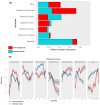Predicting Disparity between ASF-Managed Areas and Wild Boar Habitats: A Case of South Korea
- PMID: 38003100
- PMCID: PMC10668782
- DOI: 10.3390/ani13223482
Predicting Disparity between ASF-Managed Areas and Wild Boar Habitats: A Case of South Korea
Abstract
African swine fever (ASF) is a highly contagious viral disease affecting both domestic and wild boars. Since its first outbreak in South Korea in 2019, substantial efforts have been made to prevent ASF transmission by reducing the wild boar population and eliminating infected carcasses; however, the persistence of ASF transmission has posed challenges to these efforts. To improve ASF management strategies, the limitations of current management strategies must be identified by considering disparities between wild boar habitats and ASF-managed areas with environmental and anthropogenic characteristics of wild boars and their management strategies. Here, ensemble species distribution models were used to estimate wild boar habitats and potential ASF-managed areas, with elevation, distance to urban areas, and Normalized Difference Vegetation Index as important variables. Binary maps of wild boar habitats and potential ASF-managed areas were generated using the maxSSS as the threshold criterion. Disparity areas of ASF management were identified by overlying regions evaluated as wild boar habitats with those not classified as ASF-managed areas. Dense forests near urban regions like Chungcheongbuk-do, Gyeongsangbuk-do, and Gyeongsangnam-do were evaluated as disparity areas having high risk of ASF transmission. These findings hold significant potential for refining ASF management strategies and establishing proactive control measures.
Keywords: ASF; SDM; disease management strategies; potential risk areas; transmission pathways.
Conflict of interest statement
The authors declare no conflict of interest.
Figures







Similar articles
-
Predicting Suitable Areas for African Swine Fever Outbreaks in Wild Boars in South Korea and Their Implications for Managing High-Risk Pig Farms.Animals (Basel). 2023 Jun 29;13(13):2148. doi: 10.3390/ani13132148. Animals (Basel). 2023. PMID: 37443946 Free PMC article.
-
Modelling the Spatial Distribution of ASF-Positive Wild Boar Carcasses in South Korea Using 2019-2020 National Surveillance Data.Animals (Basel). 2021 Apr 22;11(5):1208. doi: 10.3390/ani11051208. Animals (Basel). 2021. PMID: 33922261 Free PMC article.
-
Identification of African swine fever virus genomic DNAs in wild boar habitats within outbreak regions in South Korea.J Vet Sci. 2021 Mar;22(2):e28. doi: 10.4142/jvs.2021.22.e28. J Vet Sci. 2021. PMID: 33774943 Free PMC article.
-
African Swine Fever in Wild Boar in Europe-A Review.Viruses. 2021 Aug 30;13(9):1717. doi: 10.3390/v13091717. Viruses. 2021. PMID: 34578300 Free PMC article. Review.
-
A Review of Environmental Risk Factors for African Swine Fever in European Wild Boar.Animals (Basel). 2021 Sep 14;11(9):2692. doi: 10.3390/ani11092692. Animals (Basel). 2021. PMID: 34573659 Free PMC article. Review.
Cited by
-
Human-Wildlife Conflict Mitigation Based on Damage, Distribution, and Activity: A Case Study of Wild Boar in Zhejiang, Eastern China.Animals (Basel). 2024 May 30;14(11):1639. doi: 10.3390/ani14111639. Animals (Basel). 2024. PMID: 38891686 Free PMC article.
-
Spatial prediction of wild boar distribution in Thailand applications for African swine fever prevention and control.Sci Rep. 2025 Mar 22;15(1):9987. doi: 10.1038/s41598-025-94922-1. Sci Rep. 2025. PMID: 40121282 Free PMC article.
References
-
- Granoff A., Webster R.G. Encyclopedia of Virology. Elsevier; Memphis, TN, USA: 1999.
-
- Lee S.H., Kim Y.J., Lee S.H., Lee E.H., Park J.J., Park K.H., Sunwoo S.Y., Lee J.G. A Study on Improvement Plan for Establishing a Farm Level ASF Control Strategies. Gyeonggi Research Institute; Suwon, Republic of Korea: 2020. pp. 1–133. (In Korean)
Grants and funding
LinkOut - more resources
Full Text Sources

